The Pomegranate tree is usually 12 to 20 feet long and almost the same in the spread. When growing a Pomegranate tree, patience is required because the fruit takes five to seven months to mature, and the tree itself needs two to three years before it bears more than a couple of fruits. Also, the Pomegranate tree loses its excitement after 15 years or more, although some cultivars can survive hundreds of years.
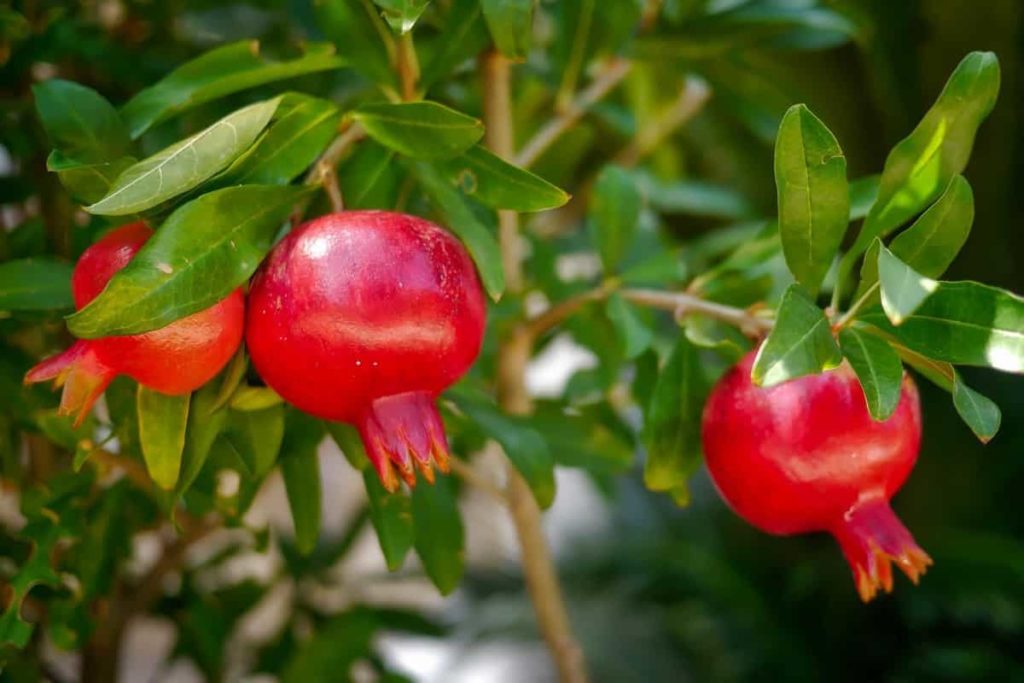
Pomegranate is usually a pest and disease-free plant that rarely sees anything more than cosmetic damage caused by pests. Pomegranates also suffer from growing problems like losing leaves, flower and fruit drops, and discoloration. All these problems are overcome by giving the necessary needs of Pomegranate. Let’s check out common Pomegranate tree/plant problems below.
Common Pomegranate tree/plant problems
The Pomegranate tree is losing leaves
Pomegranate leaves turn very yellow before falling to the ground in the fall and winter. However, falling Pomegranate leaves at other times of the year may indicate something else.
Improper maintenance
Before planting your new Pomegranate plant, ensure the roots are healthy. If it is root-bound, return the plant. Those roots will continue to circle the root ball and harden, eventually suffocating the plant’s water and nutrient distribution system. This can destroy Pomegranate tree leaves and kill an unhealthy, low-fruit-bearing tree or tree death.
Solution – You should repot route-bound plants.
Drought stress
Pomegranate trees survive long periods of drought, but a prolonged water ban can lead to the fall of Pomegranate leaves and the death of the entire plant.
Solution – Make sure you irrigate your Pomegranate properly.
Pests
Pests can also cause the loss of Pomegranate leaves. The aphids can suck the juice from your Pomegranate leaves.
Solution – You can spray leaves with a strong blast of water to wash off the aphids. You can also bring natural predators, such as ladybugs, or light, organic insecticidal soap on the aphides. Remember that there are many common reasons for losing Pomegranate leaves. Some are part of the normal cycle of development. Others are easily treated.
Pomegranate tree leaves turning yellow
Pomegranates are trees that thrive on neglect, but that doesn’t mean they are completely invincible. Yellow leaves can give clues as to what could be wrong with your tree if you listen to them carefully. Keep an eye on these common causes of yellow leaves on Pomegranates.
- Cooling temperature – If you feel yellow leaves as temperatures cool and there are no other signs of stress, chances are good that your tree is only heading for winter slumber.
- Overwatering – After climate changes, the most common reason that yellows on Pomegranates are to water them more. It is natural to nurture fruit plants, but Pomegranates, unlike most fruit-bearers, are native to dry, arid areas and don’t do well with a lot of water.
Solution – Let them dry completely in the middle of the waterings and limit the amount of fertilizer or mulch you apply to the root area.
- Inappropriate feeding – Too much fertilizer can result in root burning and yellow leaves, but little nitrogen deficiency and mild green to yellow leaves.
Solution – Your best bet is to closely monitor your tree and feed it if it starts lightening the color of your leaf. It’s an excellent time to feed the tree to help it successfully bear fruit immediately after it blooms.
Pomegranate leaves curling
A lack of calcium and magnesium can usually cause leaf curl in Pomegranate. When the low micronutrients, the leaf tips turn brown and downwards. Stagnate tips of these leave color and turn in the form of a hook shape.
Solution – The first’s advice would be to test the soil to find out what your soil is lacking. Usually, using a fertilizer that contains micronutrients will solve the problem of leaf tip curl.
The Pomegranate tree is not blooming
Lack of direct light
Pomegranate needs direct sunlight to grow and thrive well. If it is in semi-shadow, indoors/greenhouse, or is somehow safe, it will not be able to produce flowers because it lacks energy.
Solution – Keep it in a bright area. If you’ve never found the sun before, you’ll have to adjust slightly, so your leaves don’t suffer a burn. To do this, you must get used to getting 1 or 2 hours of light daily. Then, you can add exposure time little by little.
In case you missed it: How to Prepare the Soil for Pomegranate Plants/Trees: Best Soil Mixture, Ph, and Compost
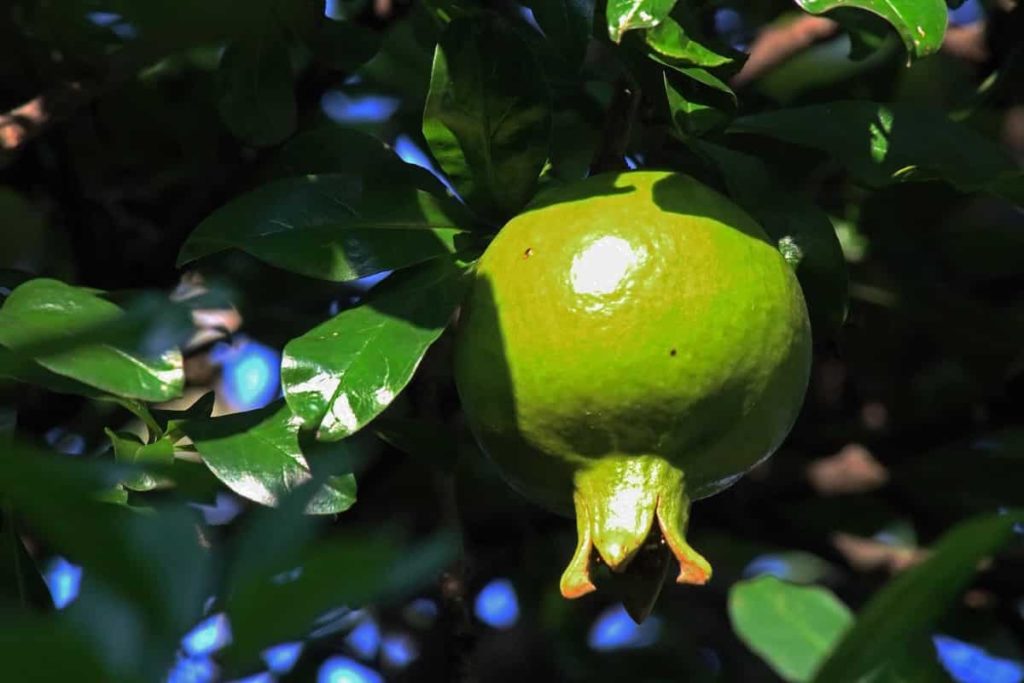
Age
The dwarf Pomegranate is a tree that blooms early at 1 to 2 years; instead, the common type takes about 5 or 6 years if you get water regularly. When a plant produces flowers for the first time, we can generally assume that it is ready to produce its fruits and thus play a role in creating new generations.
Solution – Provide direct sun, regular watering throughout the year, and make some organic fertilizer contributions in spring and summer.
Lack of space
If there is no room for growth in its roots, the plant will not be able to produce flowers. This can happen even if you grow in the garden. Roots need space, air, water, and nutrients to develop.
Solution – If planted in the pot, it should be planted to another with a diameter of about 7 to 10 centimeters and deeper than what you now have. Similarly, there should be holes under this container because Pomegranate is a plant that does not stop water from accumulating. Also, you don’t have to put a plate or tray under it, as the water will stagnate and the roots will rot.
Pruning
You can prune Pomegranate but in moderation. When too much is pruned, the plant will consume energy that will try to recover, that is, to heal the wounds and move forward, not to thrive. But if it is the case that before these wounds are sealed, some microorganisms enter will prolong the recovery time. It’s rare for Pomegranate, but you can’t deny it.
Solution – In these circumstances, water is required from time to time to keep your Pomegranate hydrated. In addition, treating it with multipurpose fungicides is advised as you can keep them away if it has fungi.
Pomegranate flower drop
There are several reasons for the flower drop in Pomegranate flowers.
Pollination
Pomegranate trees are productive, meaning that the flowers on Pomegranate are male and female. Pollinated insects and hummingbirds help spread pollen from flower to flower. You can even help by using a small brush and lightly brushing from bloom to bloom.
Pests
If your Pomegranate flowers fall in early spring, the culprit can be an attack of pests such as white flies, scales, or mealybugs. Inspect the tree regularly, and use suitable pesticides.
Disease
Another possible cause of Pomegranate flower fall could be fungal disease or root rot. To prevent this, apply the antifungal spray.
Environmental
The tree can also drop flowers due to cold temperatures.
Solution – Protect or move a tree if it is in the chill forecast. Finally, although the tree drought is resistant, it still needs good deep water if you want it to produce fruit. Very little water will cause flowers to fall from the tree. Pomegranate trees need to mature to produce fruit for three to five years.
Before that, as long as the tree is watered, fertilized, properly pollinated, and devoid of pests and diseases, a small drop of Pomegranate flowers is natural, and there is no cause for danger. Just be patient, and eventually, you can enjoy the delicious ruby-red fruit of your exotic Pomegranate.
In case you missed it: Best Fertilizer for Pomegranate Tree: Homemade, Natural, Organic, and Compost Manure

So many flowers but no fruit
Pomegranates are usually pollinated, meaning they do not need pollen from any other Pomegranate tree to produce fruit. There are two main species of the Pomegranate tree, one that bears fruit and one which is decorative and only bears flowers. You won’t get many or no fruits if you have a flower variety. If you have a fruit type and it’s not producing fruit or falling from the tree before they are ripe, several problems can cause this problem.
Pollination
It doesn’t matter if your tree itself is pollinated or cross-pollinated, because either it has to happen, then there should be a pollen exchange between male and female flowers. Insects or hummingbirds facilitate it. If pesticide use is common in your area, there may be a shortage of flies and other pollinating insects. Or it may be that your garden attracts only a few if you don’t have many flowering plants to encourage insect sightings.
Solution – Plant more flowering plants to attract insects.
Tree health
The health of your Pomegranate tree is affected by many things, and if your tree is not healthy, it won’t produce many fruits.
Solution – Although known for tolerating a wide range of soil types, Pomegranates will always do best in rich, loamy soils with plenty of nutrients and drain well. The pH is also less important for Pomegranate than for other fruit trees, but for the best results, it should still be between 5.5 and 7.2.
You can use soil amendments to improve it in any way. Your tree is not getting enough nutrients if your tree is in sandy soil, it may be that. Or, if you’re feeding your tree, you’ve probably fed nitrogen more, which, although it produces a large amount of amazing green leaves to your tree, will reduce fruit production.
Water stress is a common reason fruit trees drop their flowers or fruits prematurely. Make sure your tree takes quite deep water a couple of times weekly. Giving more water during dry periods should help prevent this. If the Pomegranate tree is suffering from a disease, it can be very weak to produce fruits.
Similarly, an overload of insects can cause problems in fruit production. Make sure you treat diseases and pests quickly using low-environmental impact products. Insufficient sunlight will prevent your fruits from ripening. Pomegranates are sun lovers and love staying in full sun for at least six hours daily.
Pruning
Pomegranate trees may require sufficient pruning to keep in shape, a common mistake is to prune too much.
Solution – Pomegranates mostly produce fruit on the wood grown in the previous or current year. If you cut all this wood, it will not produce any fruit. Remove some of last year’s growth when pruning, so there is still a lot left for fruit production. Pruning is usually good every year, as it stimulates branches and is an opportunity for your tree to have more fruity branches.
Pomegranate fruits split on the tree
Water stress
When plants bloom and produce fruit simultaneously between spring and fall, they usually need more water.
Solution – If you live in a region with a rain shortage, providing one inch of extra water per week per plant is better to prevent Pomegranates from coming under stress during drought. You can install an irrigation system to water multiple trees or shrubs or if you sometimes forget to water your plants.
Nutrient deficiency
Poor soil with less organic material or more clay or sand may lack essential nutrients that contribute to plant growth and bud and fruit growth. Many signs of distress can be obvious without these nutrients, such as growth loss, coloring, and bud drops. Deficiencies can lead to many problems with fruit preparation, especially in the early stages. Fruits that do not obtain enough potassium or calcium may show signs of chlorosis or discoloration that serve as “bleaching,” which can prevent before cracking and splitting.
Solution – Prevention is the best way to correct deficiencies, as soil modification is very easy before correcting poor growth or loss after fruit formation. If the fruits are already splitting, unfortunately, it will be too late to fix for the current growing season. If the soil test results determine the soil is deficient in nutrients, you will most likely need to apply fertilizer. Pomegranates do not prefer heavy applications, so selecting the appropriate fertilizer type and delivery method is important for the best results.
In case you missed it: Pomegranate Growing Tips, Ideas, Techniques, Secrets
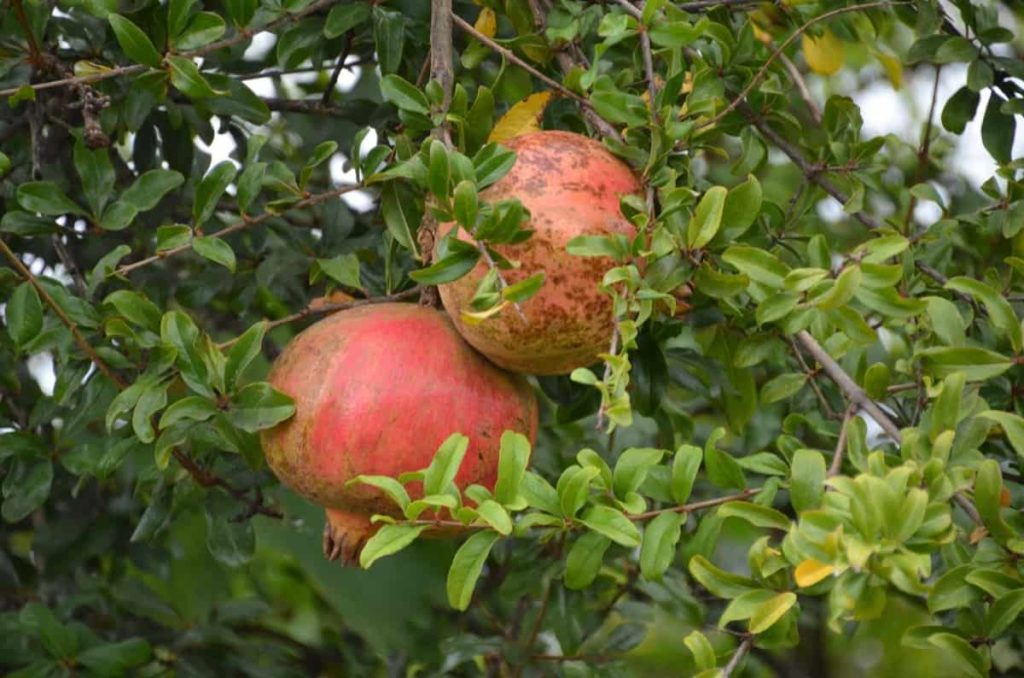
Temperature fluctuations
Rapid temperature changes can also cause splitting. While they usually endure a lot of heat, a big jump from minimum temperatures can still cause damage.
Solution – Unfortunately, it is very difficult to prevent cracking due to temperature changes, but ensuring that your plant is given proper water can help. Covering or moving pots to protect against shade or cold can also help if you grow trees in a container.
Overripening
Solution – It is not easy to know when the fruits are completely ripe and ready for the crop. Regularly check the size of the Pomegranate fruit; it will tell when you harvest.
Heart rot disease
Although Pomegranates are hard trees that are not particularly susceptible to disease, cracking is known to lead to rotten fruits.
Solution – Currently, there is no known treatment for heart rot, although applying the fungicides early in the growing season can prevent infection.
Diseases
Cercospora fruit spot
Cercospora fungus causes brown spots on your Pomegranate leaves. This can also cause the leaves to become yellow and curl. The leaves can fall severely due to serious diseases. This fungus thrives in warm, humid conditions.
Solution – Remove the infected leaves and treat your tree with fungicides to prevent spread.
Alternaria fruit rot
Alternaria is also known as black rot and damages the fruit in the form of lesions and rot on the fruit’s interior. This happens after heavy rains when fruit starts forming.
Solution – Remove and destroy the affected parts, and apply suitable fungicides.
Botrytis
Botrytis, a gray mold familiar with any farmer of tropical fruits, affects trees during flowers. Seeds penetrate flowers and stay in hibernation during fruiting. It is activated during post-harvest washing and spreads like wildfire through all the harvested fruits.
Solution – Fungi problems should begin to be overcome before fruit growth in early spring and continue during summer as fruits mature. Use copper fungicides per instructions and promote good circulation by pruning. You cannot fully understand many of the exact causes of these diseases, but fungicide use and proper plant cultivation can help the tree deal with minor diseases.
In case you missed it: Growing Pomegranate In The Backyard
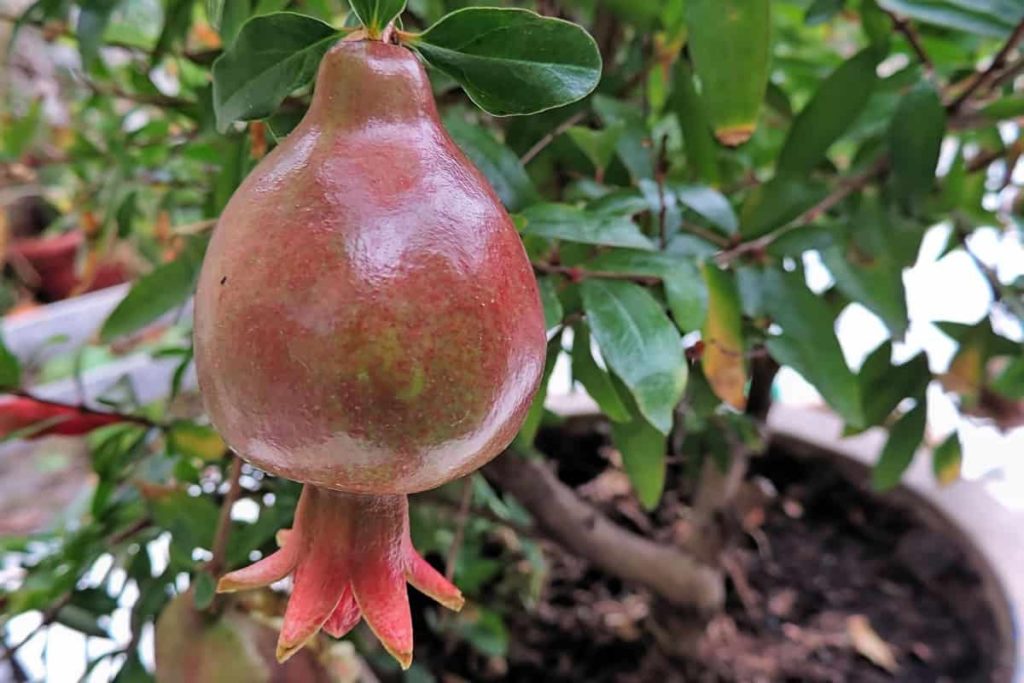
Pests
Aphids
Adults and nymphs suck the juice from growing shoots, flowers, and young fruits. The heavy attack leads to stunts or a weak tree.
Solution – You should encourage natural enemies. Keep the field weed-free. Spray a strong water jet to remove the aphids. If the infection is severe, spray the appropriate pesticide.
Leaf-footed plant bugs
Both adults and nymphs feed their mouth parts into the thick skin of Pomegranate fruit to arils, resulting in the wilting of stung arils.
Solution – Apply appropriate pesticide if the attack is severe.
Mealybugs
The insect infects all parts of the plant. Nymphs and adults suck the sap from leaves, flowers, and fruits, causing yellow leaves, curling, and tender fruits. In addition, the market value of such fruits is also reduced. In dry weather, insects can attack the roots and suck the juice.
Solution – Soap solution spray reduces the population of the mealybug. Encourage natural enemies. If the attack is severe, apply proper pesticides.
Omnivorous leafroller
It causes tunnels in fruits. Secondary germs can affect fruits due to damage to the skin and rot as a result.
Solution – Keep the field weed-free. Remove and burn the affected fruits. Use a pheromone trap to kill adult insects.
Pomegranate fruit borer
The female butterfly lays eggs on the tender leaves. The larvae feed fruit through boring holes after hatching.
Solution – Remove the damaged fruit and burn them. If the infection is severe, spray the appropriate pesticide.
In case you missed it: Pomegranate Seed Germination, Time, Process (Anar)
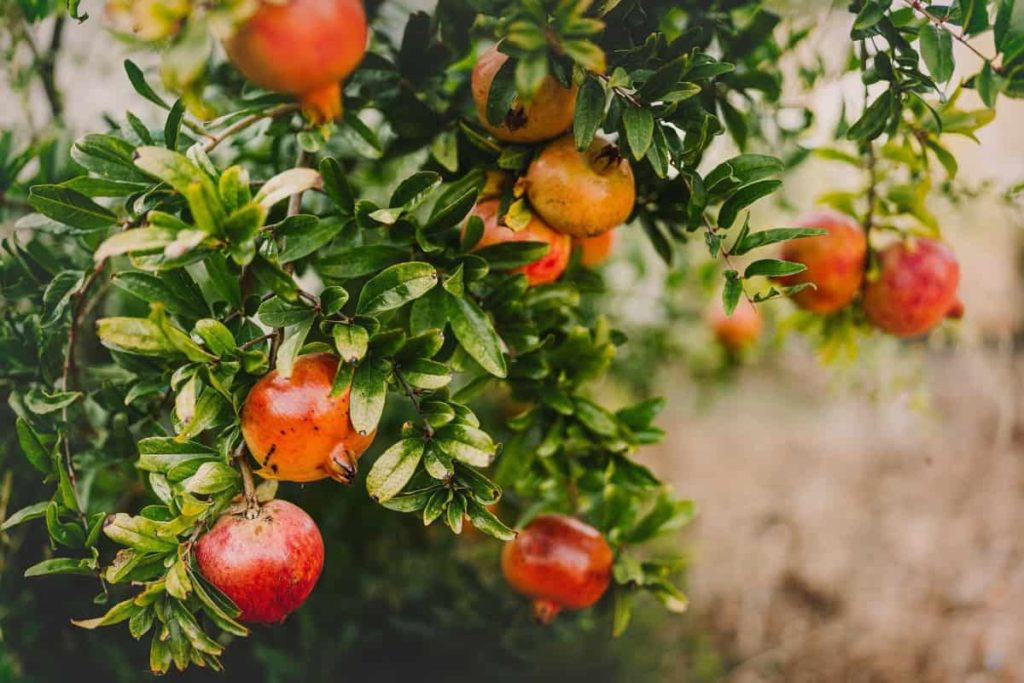
Conclusion
Pomegranate is commonly affected by fungi diseases in plants grown in wet areas in spring and early summer. Other diseases, pests, and growing problems in Pomegranate are rare and do not permanently damage the tree. You should know about the Pomegranate problems and see if this plant is right for you and your region. Follow the above-mentioned solutions to get a healthy Pomegranate fruit.
- How to Grow Tomatoes Organically at Home: A Comprehensive Guide
- Organic Gardening on a Budget: Low-Cost Methods and Materials
- Gongura Seed Germination and Planting Methods
- Cabbage Seed Germination and Selection
- Broccoli Seed Germination and Selection
- Asparagus Seed Germination and Variety Selection
- Seasonal Flower Gardening: Best Practices for Spring, Summer, Fall, and Winter
- How to Grow Hibiscus from Flower
- Plantation Ideas for Home Decoration: A Beginners Guide
- Flower Garden Designs and Layouts for Beginners
- Planting and Spacing Techniques in Papaya: A Beginner’s Guide
- Growing Gold: Essential Techniques for Planting Pineapples
- How to Make Kalanchoe Plant Bushy: Home Remedies and Solutions
- 11 Reasons Why Your Gardenia is Not Blooming: Home Remedies and Solutions
- Eco Elegance: The Guide to Designing a Drought-Tolerant Landscape
- Gardening on a Slope: Strategies for Hillside Landscaping
- Nourish and Flourish: Top Organic Mulches for Thriving House Plants
- Everything You Want to Know about Indian Mogra Flower: Discover Uses and Growing
- Green Thumb Success: Expert Tips for Cultivating Greenhouse Pumpkins All Year Round
- Maximize Growth & Flavor: The Ultimate Guide to Companion Planting in Herb Gardens
- How to Control Rhododendron Problems Naturally: Home Remedies and Organic Ways to Fix Them
- Natural Magic: The Remarkable Benefits of Cinnamon for Plants
- Best Steps to Revive Dying Tulip with Natural and Organic Treatment
- 10 Reasons Why Your Angel Trumpet is Not Blooming: Remedies and Treatment
- How to Fix Periwinkle Leaf and Flower-Related Problems: Natural Remedies and Solutions
- How to Fix Zinnias Leaf and Flower Problems: Discover Natural and Home Remedies
- Organic Steps to Induce Lemon Tree Flowers: A Comprehensive Guide
- Bloom Booster: Crafting the Perfect Homemade Bougainvillea Fertilizer
- Optimizing Growth: A Guide to Applying NPK Fertilizer for Potted Plants
- 10 Best Homemade Fertilizers for Rubber Plant: DIY Recipes and Application Method
- How to Boost Female Pumpkin Flowers: Effective Steps for More Flowers and High Yields
- Transform Your Indoor Garden: Top Benefits of Pink Salt for Houseplants
- 10 Best Homemade Fertilizers for Peacock Plants (Calathea): Easy DIY Guide
- Unlock Blooms: 9 Reasons Why Your Potted Chrysanthemum is Not Blooming
- 8 Reasons Why Your Potted Hibiscus is Not Blooming: Fix it with Simple Solutions
- Unlock Blooms: 9 Key Reasons Your Potted Frangipani Won’t Flower
This is a great site. When will you have app for iOS apple devices? I have yellowing leaves on one of my new pomegranate trees I planted this spring. The other one seems to be doing OK. This info was very helpful. I’m in the high desert outside of Los Angeles. Thanks.